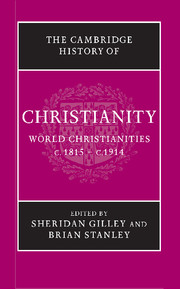Book contents
- Frontmatter
- 1 Introduction
- PART I CHRISTIANITY AND MODERNITY
- 2 The papacy
- 3 Theology and the revolt against the Enlightenment
- 4 The growth of voluntary religion
- 5 Catholic revivalism in worship and devotion
- 6 Women preachers and the new Orders
- 7 Church architecture and religious art
- 8 Musical trends and the western church: a collision of the ‘ancient’ and ‘modern’
- 9 Christianity and literature in English
- 10 Christian social thought
- 11 Christianity and the sciences
- 12 History and the Bible
- 13 Popular religion and irreligion in countryside and town
- PART II THE CHURCHES AND NATIONAL IDENTITIES
- PART III THE EXPANSION OF CHRISTIANITY
- Select General Bibliography
- Chapter Bibliography
- Index
- References
8 - Musical trends and the western church: a collision of the ‘ancient’ and ‘modern’
from PART I - CHRISTIANITY AND MODERNITY
Published online by Cambridge University Press: 28 March 2008
- Frontmatter
- 1 Introduction
- PART I CHRISTIANITY AND MODERNITY
- 2 The papacy
- 3 Theology and the revolt against the Enlightenment
- 4 The growth of voluntary religion
- 5 Catholic revivalism in worship and devotion
- 6 Women preachers and the new Orders
- 7 Church architecture and religious art
- 8 Musical trends and the western church: a collision of the ‘ancient’ and ‘modern’
- 9 Christianity and literature in English
- 10 Christian social thought
- 11 Christianity and the sciences
- 12 History and the Bible
- 13 Popular religion and irreligion in countryside and town
- PART II THE CHURCHES AND NATIONAL IDENTITIES
- PART III THE EXPANSION OF CHRISTIANITY
- Select General Bibliography
- Chapter Bibliography
- Index
- References
Summary
To appreciate the part played by church music in the nineteenth century, specifically in continental Europe and Britain, it is vital to acknowledge a number of key issues, most of them inherited from the second half of the eighteenth century. The new secular age, heralded by the philosophical developments of the Enlightenment and major events such as American Independence and the French Revolution, signalled a sea-change in music’s function within society, and the church, once the principal patron, and indeed custodian, of musical ‘progress’, saw its relationship with the art and its diverse profession decline as other musical genres became the foci for creativity and ambition. The opera house replaced the church as the ‘cathedral’ of the bourgeoisie, while the concert hall became the home of the new cultural intelligentsia and cognoscenti as instrumental music assumed a supremacy over vocal. As Julian Rushton has pointed out, ‘churches were themselves partly responsible for the fact that their liturgies were no longer the natural home of advanced musical art’.
Eighteenth-century Lutheran music provides an apposite illustration of how the steady growth of pietism and the influence of Calvinism witnessed a decline away from the ornate creations of cantatas, motets and chorale preludes, until, by 1800, the music of German Protestantism consisted of little more than the singing of chorales. No better example of this process can be observed than at Leipzig by the comparison between J. S. Bach’s sophisticated sacred works written for his post as cantor at St Thomas’s Church, and those of his successor, J. A. Hiller, who wrote little for the liturgy. Though less draconian, the Catholic Church was also driven by a reforming zeal which eschewed the use of instrumental music in the liturgy except as a subordinate role to voices.
- Type
- Chapter
- Information
- The Cambridge History of Christianity , pp. 121 - 135Publisher: Cambridge University PressPrint publication year: 2005

